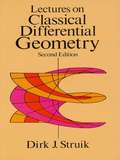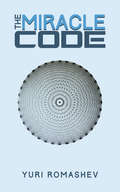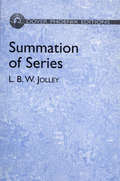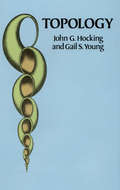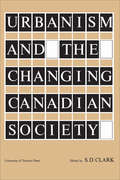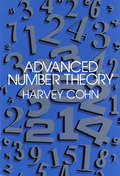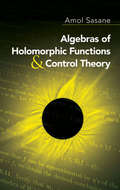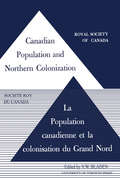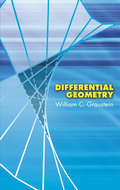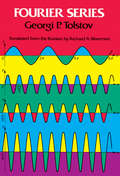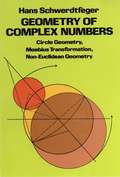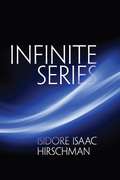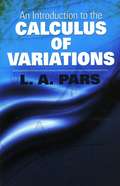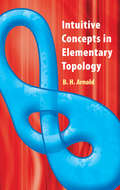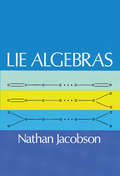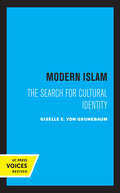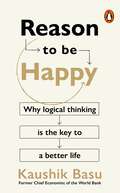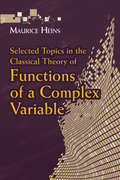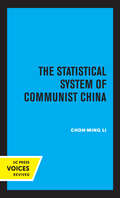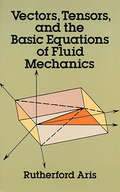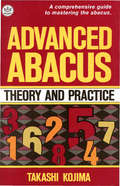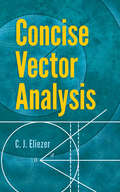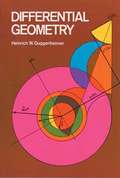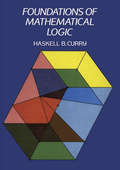- Table View
- List View
Lectures on Classical Differential Geometry: Second Edition (Dover Books on Mathematics)
by Dirk J. StruikElementary, yet authoritative and scholarly, this book offers an excellent brief introduction to the classical theory of differential geometry. It is aimed at advanced undergraduate and graduate students who will find it not only highly readable but replete with illustrations carefully selected to help stimulate the student's visual understanding of geometry. The text features an abundance of problems, most of which are simple enough for class use, and often convey an interesting geometrical fact. A selection of more difficult problems has been included to challenge the ambitious student.Written by a noted mathematician and historian of mathematics, this volume presents the fundamental conceptions of the theory of curves and surfaces and applies them to a number of examples. Dr. Struik has enhanced the treatment with copious historical, biographical, and bibliographical references that place the theory in context and encourage the student to consult original sources and discover additional important ideas there.For this second edition, Professor Struik made some corrections and added an appendix with a sketch of the application of Cartan's method of Pfaffians to curve and surface theory. The result was to further increase the merit of this stimulating, thought-provoking text -- ideal for classroom use, but also perfectly suited for self-study. In this attractive, inexpensive paperback edition, it belongs in the library of any mathematician or student of mathematics interested in differential geometry.
The Miracle Code
by Yuri RomashevWhat were the creators of roulette trying to conceal? What exactly is a symmetric division of space? Did the game of roulette originate with the Mayas? What is perhaps the invisible material that unites the universe? Three interesting discoveries are described in this book, the secret of the game of roulette, the mystical attraction between numbers and the hidden formula of the Maya calendar (Tzolkin of 260 days). This is why the Miracle Code is not just a way to enhance your winnings at the casino from the official 2.7% to more than 20%. The attraction between numbers might well be the basis for the division of energy in space. Is man just one component of a comprehensive programme that has constantly repeated itself throughout history? No other publication has focused on this information and that makes this book so unique.
Summation of Series
by L.B. W. JolleyOver 1,100 common series, all grouped for easy reference. Arranged by category, these series include arithmetical and geometrical progressions, powers and products of natural numbers, figurate and polygonal numbers, inverse natural numbers, exponential and logarithmic series, binomials, simple inverse products, factorials, trigonometrical and hyperbolic expansions, and additional series. 1961 edition.
Topology
by John G. Hocking Gail S. Young"As textbook and reference work, this is a valuable addition to the topological literature." -- Mathematical ReviewsDesigned as a text for a one-year first course in topology, this authoritative volume offers an excellent general treatment of the main ideas of topology. It includes a large number and variety of topics from classical topology as well as newer areas of research activity.There are four set-theoretic chapters, followed by four primarily algebraic chapters. Chapter I covers the fundamentals of topological and metrical spaces, mappings, compactness, product spaces, the Tychonoff theorem, function spaces, uniform continuity and uniform spaces. The next two chapters are devoted to topics in point-set topology: various separation axioms, continua in Hausdorff spaces, real-valued functions, and more Chapter IV is on homotopy theory. Chapter V covers basic material on geometric and abstract simplicial complexes and their subdivisions. Chapter VI is devoted to simplicial homology theory, Chapter VII covers various topics in algebraic topology, including relative homology, exact sequences, the Mayer-Vietoris sequence, and more. Finally, Chapter VIII discusses Cech homology.There are a large number of illuminating examples, counter-examples and problems, both those which test the understanding and those which deepen it. The authors have also made a special effort to make this an "open-ended" book, i.e while many topics are covered, there is much beyond the confines of this book. In many instances they have attempted to show the direction in which further material may be found.Topology is so fundamental, its influence is apparent in almost every other branch of mathematics, as well as such fields as symbolic logic, mechanics, geography, network theory, and even psychology. This well-written text offers a clear and careful exposition of this increasingly important discipline.
Urbanism and the Changing Canadian Society
by S. D. ClarkIn this collection of essays the changing structure of the Canadian community, especially in its urban growth, is brought before the reader with many fresh insights, much vigorous comment, and apt illustration. The authors, concentrating on certain kinds of problems which have interested them individually, provide for student and general reader stimulating analysis of social phenomena which are under lively examination these days in Canada and beyond both in popular and semi-popular journals and magazines and in learned writings.Nathan Keyfitz opens the volume with a valuable background analysis of the way in which the population of Canada has reached its present numbers and distribution and examines the effects of immigration and of changing rates of birth and death. S.D. Clark deals with the controversial question of what the real characteristics of the suburban community can be seen to be and comments forcefully on the "suburbia" of Riesman, Whyte, et al. W.E. Mann presents a fascinating analysis of the patterns of life in a slum area of Toronto which swarms with factory workers and truck-drivers, with people of many racial origins, and which has developed social habits based largely on rooming-houses, small shops, and pubs. Jean Burnet provides an historical account of changing moral standards of sobriety and piety as reflected in sabbatarian and temperance movements in Toronto, long regarded as the quintessence of severity. Oswald Hall gives a valuable analysis of the patterns of growth in the professions and of the kinds of competitive struggles going on within them and at the borders between them as new groups strive to win this status in society. P.J. Giffen takes up an important related question of how interests of a self-governing profession relate to the expectations of the public and uses the legal profession as his example. Finally, Leo Zakuta adds to the scanty literature on Canadian political parties an analysis of the changing character of the C.C.F., long the dominant force in left-of-centre politics.The authors all are, or have been members of the staff in sociology at the University of Toronto, and their essays convey an excellent picture of the liveliness of the work they jointly carry forward. This volume will thus serve not only to introduce students to some of the kinds of problems sociologists are thinking about but will also make better known to them as a group some of the sociologists in Canada who are engaged with them.
Advanced Number Theory
by Harvey Cohn"A very stimulating book ... in a class by itself." -- American MathematicalMonthlyAdvanced students, mathematicians and number theorists will welcome this stimulating treatment of advanced number theory, which approaches the complex topic of algebraic number theory from a historical standpoint, taking pains to show the reader how concepts, definitions and theories have evolved during the last two centuries. Moreover, the book abounds with numerical examples and more concrete, specific theorems than are found in most contemporary treatments of the subject.The book is divided into three parts. Part I is concerned with background material -- a synopsis of elementary number theory (including quadratic congruences and the Jacobi symbol), characters of residue class groups via the structure theorem for finite abelian groups, first notions of integral domains, modules and lattices, and such basis theorems as Kronecker's Basis Theorem for Abelian Groups.Part II discusses ideal theory in quadratic fields, with chapters on unique factorization and units, unique factorization into ideals, norms and ideal classes (in particular, Minkowski's theorem), and class structure in quadratic fields. Applications of this material are made in Part III to class number formulas and primes in arithmetic progression, quadratic reciprocity in the rational domain and the relationship between quadratic forms and ideals, including the theory of composition, orders and genera. In a final concluding survey of more recent developments, Dr. Cohn takes up Cyclotomic Fields and Gaussian Sums, Class Fields and Global and Local Viewpoints.In addition to numerous helpful diagrams and tables throughout the text, appendices, and an annotated bibliography, Advanced Number Theory also includes over 200 problems specially designed to stimulate the spirit of experimentation which has traditionally ruled number theory.
Algebras of Holomorphic Functions and Control Theory
by Amol SasaneThis accessible, undergraduate-level text illustrates the role of algebras of holomorphic functions in the solution of an important engineering problem: the stabilization of a linear control system. Its concise and self-contained treatment avoids the use of higher mathematics and forms a bridge to more advanced treatments. The treatment consists of two components: the algebraic framework, which serves as the abstract language for posing and solving the problem of stabilization; and the analysis component, which examines properties of specific rings of holomorphic functions. Elementary, self-contained, and constructive proofs elucidate the explorations of rings of holomorphic functions relevant in control theory. Introductory chapters on control theory and stable transfer functions are followed by surveys of unstable plants and the stabilization problem and its solution. The text concludes with suggestions for further reading and a bibliography.
Canadian Population and Northern Colonization/La Population canadienne et al colonisation du Grand Nord: Symposium presented to the Royal Society of Canada/Colloque presente a la Societe Royale du Canada (Royal Society of Canada Studia Varia Series #no. 8)
by V. W. BladenIn their annual sessions the various Sections of the Royal Society are accustomed to take up for general discussion a topic of current interest and this gives Fellows and special guests from the natural sciences, the social sciences, and the humanities an opportunity for useful communication across the disciplines on an important subject.<P><P>In 1961 the topic was an especially vital issue, the population explosion, and this volume, based on the papers given at the meeting, has much valuable information and many pertinent and provocative comments on this phenomenon particularly as it affects Canada.<P>T.W.M. Cameron leads off with a general background on the causes and consequences of the population increase around the world. Then come a group of papers presenting various aspects of the population in Canada's settled areas. Pierre Dagenais studies the growth in that population in recent years; Guy Rocher presents developments in our labour force in the 1900's with particular reference to the older age group, to women, and to the unemployed; Jacques Henripin describes ethnic and linguistic patterns over the country; Nathan Keyfitz outlines new patterns in the birth rate and their significance. A.R.M. Lower concludes this portion of the book with a lively historical study of the effects of natural increase and waves of immigration in the French and English periods, leading on to our present "bold experiment" in Canada which assumes the "risks of a non-homogeneous, non-integral society with every value fighting it out for survival."<P>The second part of the book turns to those largely unsettled areas stretching away in Canada's north and considers the potentialities of these areas as a more permanent habitat for man. With an introduction by René Pomerleau, various problems of settlement are brought forward. W. Keith Buck and D.J.F. Henderson discuss economic aspects of mineral development in the north; E.W. Humphrys, the possible use of atomic energy as a way of coping with fuel and supply; M.J. Dunbar, the prospects of support for a new population in the use natural resources contributed by the land and the sea; G. Malcolm Brown, problems of man's acclimatization to life in a colder climate; Trevor Lloyd, the kind of settlement in the Far North which is desirable and possible given its special conditions of subsistence and transportation and economic activity. All these authors stress that any planning for a northern future "must be based on a broad, systematic and thorough scientific appraisal."<P>This is an important and absorbing book and it will give both specialist and general reader much to think about.
Differential Geometry
by William C. GrausteinThis first course in differential geometry presents the fundamentals of the metric differential geometry of curves and surfaces in a Euclidean space of three dimensions. Written by an outstanding teacher and mathematician, it explains the material in the most effective way, using vector notation and technique. It also provides an introduction to the study of Riemannian geometry.Suitable for advanced undergraduates and graduate students, the text presupposes a knowledge of calculus. The first nine chapters focus on the theory, treating the basic properties of curves and surfaces, the mapping of surfaces, and the absolute geometry of a surface. The final chapter considers the applications of the theory to certain important classes of surfaces: surfaces of revolution, ruled surfaces, translation surfaces, and minimal surfaces. Nearly 200 problems appear throughout the text, offering ample reinforcement of every subject.
Fourier Series
by Georgi P. TolstovRichard A. Silverman's series of translations of outstanding Russian textbooks and monographs is well-known to people in the fields of mathematics, physics, and engineering. The present book is another excellent text from this series, a valuable addition to the English-language literature on Fourier series.This edition is organized into nine well-defined chapters: Trigonometric Fourier Series, Orthogonal Systems, Convergence of Trigonometric Fourier Series, Trigonometric Series with Decreasing Coefficients, Operations on Fourier Series, Summation of Trigonometric Fourier Series, Double Fourier Series and the Fourier Integral, Bessel Functions and Fourier-Bessel Series, and the Eigenfunction Method and its Applications to Mathematical Physics. Every chapter moves clearly from topic to topic and theorem to theorem, with many theorem proofs given. A total of 107 problems will be found at the ends of the chapters, including many specially added to this English-language edition, and answers are given at the end of the text. Richard Silverman's excellent translation makes this book readily accessible to mathematicians and math students, as well as workers and students in the fields of physics and engineering. He has also added a bibliography, containing suggestions for collateral and supplementary reading. 1962 edition.
Geometry of Complex Numbers
by Hans SchwerdtfegerSince its initial publication in 1962, Professor Schwerdtfeger's illuminating book has been widely praised for generating a deeper understanding of the geometrical theory of analytic functions as well as of the connections between different branches of geometry. Its focus lies in the intersection of geometry, analysis, and algebra, with the exposition generally taking place on a moderately advanced level. Much emphasis, however, has been given to the careful exposition of details and to the development of an adequate algebraic technique.In three broad chapters, the author clearly and elegantly approaches his subject. The first chapter, Analytic Geometry of Circles, treats such topics as representation of circles by Hermitian matrices, inversion, stereographic projection, and the cross ratio. The second chapter considers in depth the Moebius transformation: its elementary properties, real one-dimensional projectivities, similarity and classification of various kinds, anti-homographies, iteration, and geometrical characterization. The final chapter, Two-Dimensional Non-Euclidean Geometries, discusses subgroups of Moebius transformations, the geometry of a transformation group, hyperbolic geometry, and spherical and elliptic geometry. For this Dover edition, Professor Schwerdtfeger has added four new appendices and a supplementary bibliography.Advanced undergraduates who possess a working knowledge of the algebra of complex numbers and of the elements of analytical geometry and linear algebra will greatly profit from reading this book. It will also prove a stimulating and thought-provoking book to mathematics professors and teachers.
Infinite Series
by Isidore Isaac HirschmanThis text for advanced undergraduate and graduate students presents a rigorous approach that also emphasizes applications. Encompassing more than the usual amount of material on the problems of computation with series, the treatment offers many applications, including those related to the theory of special functions. Numerous problems appear throughout the book.The first chapter introduces the elementary theory of infinite series, followed by a relatively complete exposition of the basic properties of Taylor series and Fourier series. Additional subjects include series of functions and the applications of uniform convergence; double series, changes in the order of summation, and summability; power series and real analytic functions; and additional topics in Fourier series. The text concludes with an appendix containing material on set and sequence operations and continuous functions.
An Introduction to the Calculus of Variations
by L. A. ParsThis clear, rigorous introduction to the calculus of variations covers applications to geometry, dynamics, and physics. Focusing upon problems with one independent variable, the text connects the abstract theory to its use in concrete problems. It offers a working knowledge of relevant techniques, plus an impetus for further study.Starting with an overview of fundamental problems and theories, the text advances to illustrative examples and examinations of variable end-points and the fundamental sufficiency theorem. Subsequent chapters explore the isoperimetrical problem, curves in space, the problem of Lagrange, and the parametric problem. The final chapter is devoted to multiple integrals, with a particular focus on Dirichlet's principle. Suitable for advanced undergraduate and graduate students, this text requires a background in mathematical analysis.
Intuitive Concepts in Elementary Topology
by B. H. ArnoldClassroom-tested and much-cited, this concise text offers a valuable and instructive introduction for undergraduates to the basic concepts of topology. It takes an intuitive rather than an axiomatic viewpoint, and can serve as a supplement as well as a primary text.A few selected topics allow students to acquire a feeling for the types of results and the methods of proof in mathematics, including mathematical induction. Subsequent problems deal with networks and maps, provide practice in recognizing topological equivalence of figures, examine a proof of the Jordan curve theorem for the special case of a polygon, and introduce set theory. The concluding chapters examine transformations, connectedness, compactness, and completeness. The text is well illustrated with figures and diagrams.
Lie Algebras (Dover Books on Mathematics)
by Nathan JacobsonLie group theory, developed by M. Sophus Lie in the 19th century, ranks among the more important developments in modern mathematics. Lie algebras comprise a significant part of Lie group theory and are being actively studied today. This book, by Professor Nathan Jacobson of Yale, is the definitive treatment of the subject and can be used as a textbook for graduate courses.Chapter I introduces basic concepts that are necessary for an understanding of structure theory, while the following three chapters present the theory itself: solvable and nilpotent Lie algebras, Carlan's criterion and its consequences, and split semi-simple Lie algebras. Chapter 5, on universal enveloping algebras, provides the abstract concepts underlying representation theory. Then the basic results on representation theory are given in three succeeding chapters: the theorem of Ado-Iwasawa, classification of irreducible modules, and characters of the irreducible modules. In Chapter 9 the automorphisms of semi-simple Lie algebras over an algebraically closed field of characteristic zero are determined. These results are applied in Chapter 10 to the problems of sorting out the simple Lie algebras over an arbitrary field. The reader, to fully benefit from this tenth chapter, should have some knowledge about the notions of Galois theory and some of the results of the Wedderburn structure theory of associative algebras.Nathan Jacobson, presently Henry Ford II Professor of Mathematics at Yale University, is a well-known authority in the field of abstract algebra. His book, Lie Algebras, is a classic handbook both for researchers and students. Though it presupposes a knowledge of linear algebra, it is not overly theoretical and can be readily used for self-study.
Modern Islam: The Search for Cultural Identity
by G. E. Von GrunebaumThis title is part of UC Press's Voices Revived program, which commemorates University of California Press’s mission to seek out and cultivate the brightest minds and give them voice, reach, and impact. Drawing on a backlist dating to 1893, Voices Revived makes high-quality, peer-reviewed scholarship accessible once again using print-on-demand technology. This title was originally published in 1962.
Reason to Be Happy: Why logical thinking is the key to a better life
by Kaushik Basu'Reason to Be Happy is a wise and witty book that shows how thinking clearly can help us find happiness in our daily lives, get more of what we want, and even make the world a better place' Hannah FryWhy do our friends have more friends than we do? How do you book the best available seats on a plane? And if jogging for ten minutes adds eight minutes to our life expectancy, should we still go jogging?The ability to reason is one of our most undervalued skills. In everyday life, the key is to put yourself in the shoes of a clever competitor and think about how they might respond. Whether you are dealing with events on the scale of the Cuban missile crisis or letting go of anger, leading economist Professor Kaushik Basu shows how game theory - the logic of social situations - can help us achieve better outcomes and lasting happiness.Full of fascinating thought experiments and puzzles, Reason to Be Happy is a paean to the power of rationality. If you want to have a good life and even make the world a better place, you can start by thinking clearly.
Selected Topics in the Classical Theory of Functions of a Complex Variable (Dover Books on Mathematics)
by Maurice HeinsElegant and concise, this text is geared toward advanced undergraduate students acquainted with the theory of functions of a complex variable. The treatment presents such students with a number of important topics from the theory of analytic functions that may be addressed without erecting an elaborate superstructure. These include some of the theory's most celebrated results, which seldom find their way into a first course. After a series of preliminaries, the text discusses properties of meromorphic functions, the Picard theorem, and harmonic and subharmonic functions. Subsequent topics include applications and the boundary behavior of the Riemann mapping function for simply connected Jordan regions. The book concludes with a helpful Appendix containing information on Lebesgue's theorem and other topics.
The Statistical System of Communist China
by Choh-Ming LiOne of the most baffling problems in contemporary Chinese economic studies concerns the validity of official statistics. In the continuing discussion of claims and counter-claims, appeals to common sense are unconvincing. Because of the pressing need for substantial evidence on which to base a judgment, the present inquiry is an important contribution to the literature on Communist China. The book provides a quizzical but objective look at the statistical system of the country, and attempts to appraise the quality of official statistics by analyzing the development and inner working of the sytem. Its approach is broadly historical, beginning with the pre-Communist period (before 1949) and dividing the next dozen years into phases: the foundation of the state statistical system (1952 - 57), the period of decentralization (1958 - 59), and subsequent efforts at reorganization. Li's study of the development of a national statistical system in China is particularly instructive in delineating both the obstacles to such development that may be expected in a densely populated, largely agricultural country and the measure that have been adopted to overcome them. Therefore his hard-headed conclusions concerning the Chinese experience should be of lively intrest in those underdeveloped countries that are now planning or executing development programs. This title is part of UC Press's Voices Revived program, which commemorates University of California Press's mission to seek out and cultivate the brightest minds and give them voice, reach, and impact. Drawing on a backlist dating to 1893, Voices Revived makes high-quality, peer-reviewed scholarship accessible once again using print-on-demand technology. This title was originally published in 1962.
Statistical Treatment of Experimental Data
by Hugh D. YoungDealing with statistical treatment of experimental data, this text covers topics such as errors, probability, the binomial distribution, the Poisson distribution, the Gauss distribution, method of least squares and standard deviation of the mean.
Vectors, Tensors and the Basic Equations of Fluid Mechanics
by Rutherford ArisThis introductory text is geared toward engineers, physicists, and applied mathematicians at the advanced undergraduate and graduate levels. It applies the mathematics of Cartesian and general tensors to physical field theories and demonstrates them chiefly in terms of the theory of fluid mechanics. Numerous exercises appear throughout the text. 1962 edition.
Advanced Abacus
by Takashi KojimaThis volume is designed for the student desiring a greater understanding of the abacus and its calculative functions. The text provides thorough explanations of the advanced operations involving negative numbers, decimals, different units of measurement, and square roots. Diagrams illustrate bead manipulation, and numerous exercises provide ample practice. Concise and easy-to-follow, this book will improve your abacus skills and help you perform calculations with greater efficiency and precision.
Concise Vector Analysis: Mathematics Division : Concise Vector Analysis (Dover Books on Mathematics)
by C. J. EliezerThis concise introduction to the methods and techniques of vector analysis is suitable for college undergraduates in mathematics as well as students of physics and engineering. Rich in exercises and examples, the straightforward presentation focuses on physical ideas rather than mathematical rigor. The treatment begins with a chapter on vectors and vector addition, followed by a chapter on products of vector. Two succeeding chapters on vector calculus cover a variety of topics, including functions of a vector; line, surface, and volume integrals; the Laplacian operator, and more. The text concludes with a survey of standard applications, including Poinsot's central axis, Gauss's theorem, gravitational potential, Green's theorems, and other subjects.
Differential Geometry
by Heinrich W. GuggenheimerThis is a text of local differential geometry considered as an application of advanced calculus and linear algebra. The discussion is designed for advanced undergraduate or beginning graduate study, and presumes of readers only a fair knowledge of matrix algebra and of advanced calculus of functions of several real variables. The author, who is a Professor of Mathematics at the Polytechnic Institute of New York, begins with a discussion of plane geometry and then treats the local theory of Lie groups and transformation groups, solid differential geometry, and Riemannian geometry, leading to a general theory of connections. The author presents a full development of the Erlangen Program in the foundations of geometry as used by Elie Cartan as a basis of modern differential geometry; the book can serve as an introduction to the methods of E. Cartan. The theory is applied to give a complete development of affine differential geometry in two and three dimensions. Although the text deals only with local problems (except for global problems that can be treated by methods of advanced calculus), the definitions have been formulated so as to be applicable to modern global differential geometry. The algebraic development of tensors is equally accessible to physicists and to pure mathematicians. The wealth of specific resutls and the replacement of most tensor calculations by linear algebra makes the book attractive to users of mathematics in other disciplines.
Foundations of Mathematical Logic
by Haskell B. CurryThis book is a thoroughly documented and comprehensive account of the constructive theory of the first-order predicate calculus. This is a calculus that is central to modern mathematical logic and important for mathematicians, philosophers, and scientists whose work impinges upon logic.Professor Curry begins by asking a simple question: What is mathematical logic? If we can define logic as "the analysis and criticism of thought" (W. E. Johnson), then mathematical logic is, according to Curry, "a branch of mathematics which has much the same relation to the analysis and criticism of thought as geometry does to the science of space."The first half of the book gives the basic principles and outlines of the field. After a general introduction to the subject, the author discusses formal methods including algorithms and epitheory. A brief treatment of the Markov treatment of algorithms is included here. The elementary facts about lattices and similar algebraic systems are then covered. In the second half of the book Curry investigates the possibility for a formulation that expresses the meaning to be attached to the logical connectives and to develop the properties that follow from the assumptions so motivated. The author covers positive connectives: implication, conjunction, and alternation. He then goes on to negation and quantification, and concludes with modal operations. Extensive use is made in these latter chapters of the work of Gentzen. Lists of exercises are included.Haskell B. Curry, Evan Pugh Research Professor, Emeritus, at Pennsylvania State University, was a member of the Institute for Advanced Study, Princeton; a former Director of the Institute for Foundational Research, the University of Amsterdam; and President of the Association for Symbolic Logic. His book avoids a doctrinaire stance, presenting various interpretations of logical systems, and offers philosophical and reflective as well as mathematical perspectives.
